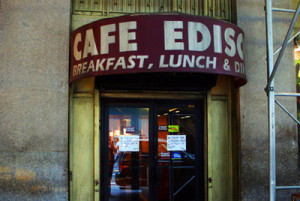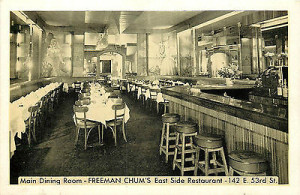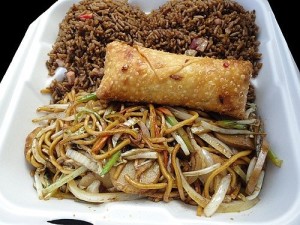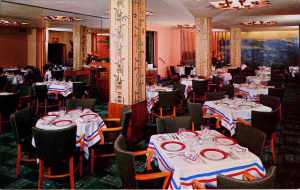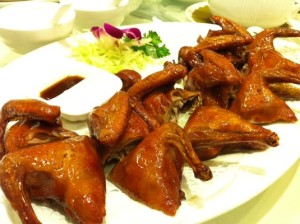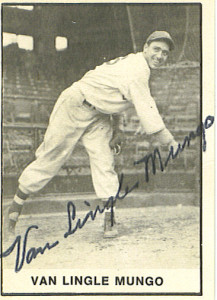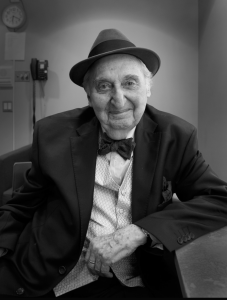HG often longs for the great breads of HG’s Bronx youth. Rye bread. Pumpernickel bread. Bialys. Onion “pletzels” (rolls). A number of grocers offer “Jewish” rye bread. HG believes this is an affront that calls for investigation by the B’nai Brith Anti-Defamation League or even more drastic action by the Jewish Defense League. Dismal present day for HG’s favorites. Pumpernickel bread? Insipid. Bialys? Other than Kossar’s, they are pale imitations without that unique oniony flavor. “Pletzels” ? They’ve disappeared. Bagels, of course, are a sardonic joke. HG doesn’t care because HG never liked bagels. Bagel lovers deserve the nasty chocolate chip and cinnamon raisin bagels now being offered. However, there’s hope. Recently, HG ordered Zabar’s sourdough seeded Jewish rye and Russian pumpernickel bread. Made HG’s eyes misty. These are the authentic loaves. Topped with scallion cream cheese and smoked fish. HG devours many slices with glasses of icy vodka (This regime draws frowns from BSK but HG shakes off disapproval). Another happy note concerning traditional Jewish baked goods. Restaurateur Daughter Victoria sent HG some “Traditional Raspberry Rugelach” (from Russ & Daughters). Spectacular. Sorry, Mom in Heaven, better than yours.
Best Baked Goods
November 20th, 2014 § 0 comments § permalink
Death Knell For Haimish Manhattan
November 10th, 2014 § 0 comments § permalink
So sad. The Cafe Edison, affectionately known as “The Polish Tearoom,” is closing its doors. The landlord (the Hotel Edison on 47th Street and Broadway in New York) is replacing it with a fancy restaurant headed by a “big name chef.” Another haimish New York restaurant bites the dust. Haimish is a Yiddish word meaning many things: Down home. With family and friends. Warm, cozy, plain and unadorned. Like eating an overstuffed sandwich at the kitchen table with Mom, Pop, your wife and the kids. Cafe Edison was decidedly Jewish with matzo ball soup, kasha varnishkes, pastrami and all the other Jewish/ Eastern European staples. Theater folks of every ethnicity gathered there daily to eat, shmooze, make deals, exchange show biz chatter. There were other theater district restaurants, not Jewish, that were haimish. Delsomma (Italian) and Fornos (Spanish). Both gone. In fact, the Jewish-Irish-Italian Manhattan where HG spent many years has vanished. The Irish bars with their corned beef and cabbage, pig’s knuckles and hard boiled eggs belong to yesterday. Italian red sauce joints are no more. The Torissi guys (Italian Specialties, Parm, Carbone, Dirty French) have upscaled Italian food ($52 veal chops, for example). Thankfully, Manhattan’s African-American and Latino population is keeping the haimish tradition alive. You can still get splendid fried chicken and catfish in Harlem. Mofongo remains on the menu in Puerto Rican eateries. Cubans in Washington Heights are still dishing up Cubanos, moros and cristianos and other good things. But, if haimish is your thing get on the subway (and ferry) and head to the boroughs. Forget Manhattan. HG, to paraphrase the song, will take The Bronx, Queens, Brooklyn and Staten Island, too.
Thanks For the Memories
November 3rd, 2014 § 0 comments § permalink
In 1954 HG partnered with a Broadway press agent and opened HG’s first public relations office in an odd little four story building, 236 W. 56th Street, on New York’s west side between Seventh and Eighth Avenues. The other tenants, like HG, were impecunious and vaguely connected with show business. The ground floor and part of the second was occupied by Patsy’s Italian Restaurant, celebrated for being one of Frank Sinatra’s favorite dining spots. It was a delightful old school restaurant featuring robust Neapolitan dishes. Though only ten years old at the time (it was founded in 1944 by Pasquale “Patsy” Scognamillo), it felt as if it had been there for decades. Prices were modest, affordable for even hand-to-mouth HG. The hosts were welcoming, generous people. They must have known that HG was struggling in his PR career because they always gave HG exuberant portions and coffee plus wine on the house. HG’s partnership dissolved. HG’s fortunes improved. HG moved to more appropriate offices on Madison Avenue. Nevertheless, HG continued to patronize Patsy’s, relishing its mozzarella in carozzo, clams arrreganata, chicken contadina and giant veal chops. Gradually, HG shifted his patronage to two other fine Italian restaurants — Delsomma on W. 47th Street and Paul & Jimmy’s on Irving Place (both long closed). While restaurants came and went, Patsy’s rolled along. It’s now in its 70th year and still owned by the Scognamillo family (It has only had three chefs in its history—all Scognamillos). Recently, HG checked the Patsy’s website. Food prices, of course, are much loftier than in the past. But, what gained HG’s attention was the wine list. Very few bottles priced less than $50 and many priced between $175 and $1,500. Yes, HG knows that New York has been taken over by the oligarchs, but still…. HG mused that New York is like an old girl friend. Cherish the memory but don’t arrange a reunion.
Freeman Chum
October 30th, 2014 § 0 comments § permalink
In the early 1950’s HG combined his career as a journalist with Broadway press agentry. HG had a part time (three months a year) girl friend, a showgirl at the Copacabana night cub. The young woman liked change. She worked five months of the year in Las Vegas, four months in Paris and the rest of the time at the Copa. When in New York, she lived in a hotel around the corner from Freeman Chum, a Chinese restaurant on Manhattan’s E. 53rd Street and that’s where she and HG drank martinis and nibbled egg rolls and spare ribs before her show. Much taller than HG, she would pat HG on the head and call him, in her inimitable Cockney drawl, “my little ducks.” When not in scanty show biz attire, she favored dowdy, tweedy English countrywoman clothes. Her ambition was to retire in the English countryside and raise beagles. Back to Freeman Chum. Odd for a Chinese restaurant, the martinis were superb, prepared by barman Hoy Wong. HG later learned that Marilyn Monroe came in every Wednesday and had a two martini liquid lunch prepared by Wong. Joe DiMaggio, the great Yankee star, would come to Freeman Chum on Saturday nights, recalled Wong, and spend secluded hours drinking scotch. (Surprisingly, he and Monroe never met there). Judy Garland was another customer and discreet Wong noted she had many drinks. Wong left Freeman Chum in 1963 and became the barman at the Blue Bar in the Algonquin Hotel. Two of his favorite customers were scotch drinkers John Lennon and Henry Kissinger. (Sometimes, this oddly matched duo shared a cocktail table). Wong had a lengthy career. He was still active at the Blue Bar when he was in his 90s. The Algonquin honored Wong on his 90th birthday (when he was there oldest barman in New York) with a cocktail party in the hotel’s Oak Room. Scores of customers were in attendance. Wong was never befuddled by odd drink requests. He said the Duke of Windsor ordered a “House of Lords martini in and out on toast.” A waiter was about to summon the kitchen. Wong stopped him. He knew the Duke wanted a gin martini with lemon peel. The lemon peel was to be burnt with a match before going into the glass. Wong said the Duke liked his version so much he ordered another.
Sandwich Heaven with A Guilty Pleasure
October 28th, 2014 § 0 comments § permalink
Some years ago HG had public relations offices on New York’s W. 57th Street (between Sixth and Seventh Avenues), a territory that remains embedded in HG’s food focused mind as “sandwich heaven.” A quick walk west brought HG to Carnegie Delicatessen for a pastrami sandwich on authentic rye with Russian dressing, sour pickles, French fries and a Dr. Brown’s Cel-Ray beverage. It was a generous plate but nothing like the overstuffed, overpriced parody of a sandwich that Carnegie serves to gullible tourists today. A shorter walk west brought HG to a coffee shop (name not recalled) for a rare roast beef sandwich with raw sliced onion on good pumpernickel bread. Potato salad and an iced coffee completed the fast feast. Sometimes HG ventured east to a deli on Sixth Avenue for smoked Nova Scotia salmon with cream cheese on an onion roll. Hot coffee. When ambitious, HG could venture just a bit further to 58th Street east of Fifth Avenue for the ultimate in sandwich perfection: This was the Reuben sandwich prepared at Reuben’s Restaurant, one of HG’s all time favorite eateries. The sandwich was incomparable. Every element–corned beef, Swiss cheese, sauerkraut, Russian dressing, rye bread–was perfect and the grilling was impeccable. Closer than Reuben’s was Rumpelmayer’s and the Monte Cristo sandwich (described in a recent post). Of course, HG could have ignored sandwiches and simply walked across the street to the Russian Tea Room for borscht and pirozshki; blini with salmon caviar and sour cream or a simple plate of eggplant orientale. Unfortunately, these dishes cried out for an accompaniment of chilled vodka which HG would not been able to resist. So, disciplined HG saved the Russian Tea Room for dinners and weekend lunches. Every two weeks or so, HG’s pal Charles E., an important advertising copywriter, would lunch with HG. (An odd fact: Charles was Jack Kerouac’s teammate on a Columbia football team.) Charles and HG would indulge in a guilty treat: Combo platters (Shrimp chop suey, egg roll, pork fried rice) served with lots of duck sauce and chinese mustard at a dingy Chinese restaurant on Sixth just north of 58th. Preceded by egg drop soup, finished with an almond cookie. Like an illicit couple, HG and Charles would leave with furtive glances, hoping that no one would note how they had breached culinary values.
Rumpelmayer’s
October 23rd, 2014 § 9 comments § permalink
Ah, Rumpelmayer’s!! That’s a name that will provoke a sigh from many older (and not so old) New Yorkers. This was a long closed restaurant/tea room/ice cream parlor in The St. Moritz Hotel (now the Ritz-Carlton) on the corner of Sixth Avenue and Central Park South. The original Rumpelmayer’s was in Vienna (with branches in London and Paris) and the New York version retained a European air (it was a favorite of Marlene Dietrich and many other European expatriates). Its design was vaguely art deco softened by heaps of colorful stuffed animals that adorned the walls and corner tables. The animals were very much liked by young customers (and were sometimes purchased for them by doting parents). A restaurant reviewer of the 1930’s called Rumpelmayer’s “the haunt of New York’s most pampered children.” Well, HG/BSK’s offspring were not pampered but they sure loved Rumpelmayer’s. As part of special occasion outings (known as “treat days”), the youngsters were seated at Rumpelmayer’s marble counter for opulent hot fudge sundaes. The ice cream was super rich. The hot fudge was really thick and warm –the sweetness being off-set by the slight bitterness of the high quality chocolate (Says SJ – Post-Rumpelmayer’s I was always disappointed by chocolate sundaes as the “hot fudge” tasted like chocolate syrup, but recently I had a Sundae at Brooklyn’s Chocolate Room and their hot fudge was of the same quality and the flavor brought me right back to Rumpelemayer’s counter). The ultimate treat. When HG had offices nearby, HG would often visit Rumpelemayer’s for a late breakfast or early lunch. HG’s food choice was a delicacy that has long disappeared from menus: The Monte Cristo Sandwich. This was a sandwich of French toast enclosing sliced ham and melted Gruyere (or Emmenthaler) cheese. Served with a pitcher of warmed maple syrup. HG would eat this lush dish, sip coffee and watch snowflakes descend upon Central Park. Nostalgia, anyone??
Tasty Little Birds
October 22nd, 2014 § 0 comments § permalink
Years ago,squab, a dish HG much enjoyed, was found on the menus of many good New York restaurants. Rarely found anymore (except in New York’s various Chinatowns in Manhattan, Brooklyn and Queens). A squab is a very young pigeon, four weeks old or less. It is a lush little bird with meat that tastes like the very best dark meat of a chicken or turkey. HG recalls eating squab prepared in many delectable ways, usually roasted: stuffed with wild rice; roasted with fresh figs; wrapped in bacon and accompanied with juicy roast grapes. As noted, squab can be found in butcher shops in Chinese neighborhoods and on Chinese restaurant menus. The squab is usually butterflied and fried. The glazed skin turns very brown and its crackling texture goes nicely with the rich flesh. Forget Chinese tea. The best accompaniment is a good red Bordeaux or Cabernet Sauvignon. The best Chinese prepared squab in North America can be found at the excellent Sun Sui Wah restaurant in the Mt. Pleasant neighborhood of Vancouver, B.C.. HG’s dining companions at the restaurant were often disconcerted when HG bit off the little bird’s head and crunched the tasty little morsel. HG has no sentimentality when it comes to dining.
Do You Miss New York?
October 19th, 2014 § 0 comments § permalink
Dave Frishberg, the witty pianist and songwriter, wrote a funny tune: “Do You Miss New York?” The song’s conclusion is affirmative. Well, HG doesn’t miss today’s New York which seems to be dominated by oligarchs and their sycophant lackeys. What HG does miss are the long departed pleasures of an older New York. HG misses the old telephone numbers (no area codes) with their lovely exchange names: MUrrray Hill, TRafalgar, GRamercy, AUdubon, KIngsbridge, BUtterfield (John O’Hara wrote an ode to this exchange in his novel “Butterfield 8). HG misses career cabdrivers named Moe, Vito and Pat who knew every nook and cranny of the city and (sometimes) were entertaining conversationalists. HG misses the pro football players who had tough guy names. Tufffy Leemans of the Giants. Bruiser Kinard and Ace Parker of the Brooklyn Dodgers (yes, youngsters, the Brooklyn Dodgers were also an NFL team). HG misses baseball players with funny, euphonious names like Van Lingle Mungo and Kirby Higbe (the lyrics to Frishberg’s song “Van Lingle Mungo” consists solely of baseball player names). HG misses trolley cars with their yellow straw seats and leisurely pace. HG misses double decker Fifth Avenue buses with their open air seating atop. HG misses the Third Avenue El. HG misses the secondhand bookstores on Fourth Avenue (later gentrified to Park Avenue South like Sixth Avenue to Avenue of the Americas). Perhaps HG just misses being young.
Sammy’s: Not For The Sensitive
September 29th, 2014 § 0 comments § permalink
Pete Wells, The New York Times restaurant critic, did a delightful, witty review of Sammy’s Romanian Steakhouse, The Cardiolgist’s Nightmare on New York’s Lower East Side. Sammy’s serves a nostalgia drenched, schmaltz (chicken fat) drenched, heavy on garlic cuisine. The place evokes the yesteryear Jewish New York of The Bronx, Brooklyn and the Lower East Side. It is loud and clamorous with music from a non-politically correct pianist. Customers, fueled by vodka from ice enclosed bottles, join in the songs and dance between the tables. There are no strangers, just one big family. Wells got it right when he called it a “permanent underground bar mitzvah where Gentiles can act like Jews and Jews can act like themselves.” The restaurant provokes strong emotions. Love it or hate it. Wells wrote: “Sammy’s is the most wonderful terrible restaurant in New York.” BSK is firmly anti-Sammy’s. HG and SJ love it. Sammy’s is a once (maybe twice) a year place. More than that is suicidial. HG once left Sammy’s full of vodka, chopped liver and silver dollar potatoes. Driving uptown on the East Side drive, HG’s equally sozzled companion pointed out he was driving in the downtown lane. Both survived. Barely. Some sensitive Jewish readers have complained about the Wells review. HG’s advice to them: “Lighten up. Sammy’s is just a Jewish joke. Have a shot of icy vodka. L’Chaim.”
The Jewish Waiter R.I.P.
September 25th, 2014 § 2 comments § permalink
The old time New York Jewish waiter has disappeared. Nostalgia, of course, colors many memories of these flat-footed, bad tempered guys. They were not subservient. They did not introduce themselves: “My Name is Moisha. I’ll be your waitperson tonight.” They were not actors, directors, artists. They were career waiters and not happy about it. Most Jewish waiters disapproved of HG. At Gitlitz, located on Broadway and 79th, the best of all delicatessens, HG always ordered a sandwich that HG’s waiter considered an abomination: Pastrami and chopped liver on rye with Russian dressing. “You sure you want Russian dressing?” “Yes.” “Feh!!”, exclaimed the waiter. At the Paramount Dairy on W. 72nd Street HG would order warm gefilte fish in broth and wave away the proffered challah (egg bread). HG would accompany the fish with buttered onion rolls, undisturbed by critical glances. The Jewish waiter attitude was exemplified by a response HG received at Moscowitz and Lupowitz on the Lower East Side. “So, what’s good tonight?”. queried HG. “Whatever we got is too good for you.” The wonderful actor Fyvush Finkel, a stalwart of the Yiddish stage, was a long time customer at Cafe Royal on Second Avenue, the hangout of Yiddish actors, musicians, composers, directors, producers, press agents, playwrights, set designers and others connected with New York’s once vibrant Yiddish theater. Finkel always sat at one waiter’s table. He would watch some beautiful pot roast go by and order it. The waiter would shake his head. “Nem (take) deh chicken.” So, Finkel ate chicken. Went on for years. “Nem deh chicken.” Then Cafe Royal closed before he could taste the pot roast. Asked why he always sat at the waiter’s table, Finkel explained: “I am a masochist.”

